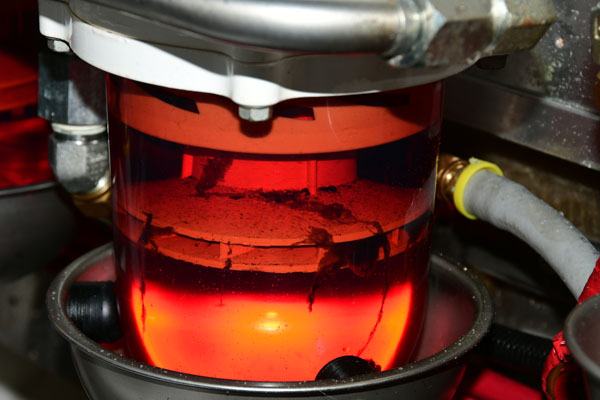Photo Essay: Fuel Filter “Seaweed”
Primary fuel filters are the first line of defense against a range of contaminants including sediment, asphaltene, and water. Most primary filters include a large, clear sight bowl that one can see through, to assess what’s inside. Water shows up as a very clearly defined line between it and the fuel, under which it invariably resides. Asphaltene, a common diesel contaminant, is visible as black sediment that collects in the bottom of sediment bowls and on the top of coalescer cones found in many filter bowls.
The contaminant shown here, which has seaweed-like tendrils, is indicative of only one thing, the presence of water within the tank, and the biological life it is supporting. Bacteria colonies can form in fuel tanks when water is present, they often produce what’s known as a bio mat, a carpet-like formation that can have dire consequences for metallic tanks in particular. One of the byproducts of the bacteria that live in this environment is hydrogen sulfide, which is acidic, and which can attack aluminum, steel and stainless steel.
The fibrous material visible in this filter is a warning sign; not only does the filter need to be cleaned (beyond just replacing the element), the tank(s) supplying it must also be drained, opened, water removed and cleaned. Don’t ignore this red signal flare being fired off by your fuel tank, it’s sending you a clear message, “CLEAN ME!”.
Ask Steve
Hi Steve,
I’m wondering if you have encountered a raw water strainer suitable for below waterline installation, offshore use on a 90′ expedition yacht that is ABYC or UL approve (what do you think about CE ratings) and is all certified plastic. Owner is fully engaged in non-corrosive components being installed.
Thank you,
Kelly Thody
Kelly:
I’ve been a fan of raw water strainers made by Groco for about two decades, they have yet to let me down. I’m partial to this ARG series, which has a clear one-piece sight bowl, and a bronze top end, although they make versions that are fully metallic. Being all bronze, I’ve never had a corrosion related failure in one of these. They do make a stainless version as well (it’s often used aboard aluminum vessels).
If the vessel is aluminum, then I’d consider either a stainless or non-metallic strainer.
ABYC has no standards specifically relating to strainers, so none can be compliant per se. ABS and other classification societies bar the use of plastic because it lacks the necessary flame resistance, so on many classed vessels you will see all metallic strainers (and the same is true for clear plastic fuel filter bowls, they cannot be used on CE and some other classed vessels, for the same reason).
Vetus does make a series of non-metallic strainers, however, interestingly, and counterintuitively, Vetus installation guidelines require these to be installed above the waterline, and while that makes them less likely to leak, it does make them more prone to air ingestion. I don’t know if these are CE approved, however, with Vetus being a European company I suspect they are.
Steve,
I have an issue with one of my water tanks, it is showing signs of rust at the lower baffler welds – weld migration? I am getting weeps now and wondering what I can do about it as the tanks are pretty inaccessible, stuck behind the engines.
Is there something that can be put into the tank when empty to seal it perhaps?
Jerry Tremain
Jerry:
I’ve encountered corroding stainless steel tanks on too many occasions, it can be a real heart ache because replacement often requires cutting up the tank in place and removing it in sections. You could try a food grade epoxy; you’d have to clean the surface very thoroughly and abrade it to create a “tooth” to enable epoxy to mechanically bond. Such a patch is tantamount to fixing a roof leak from the inside, however, as the corrosion will continue to occur inside the tank.
I’m afraid there is no internal treatment that can be used effectively and reliably to stem the rate of failure, coating the inside of any tank is challenging even when new, if it’s used it becomes almost impossible to access, clean and apply such a coating. I wish I had a more favorable response for you.
Hi Steve,
I read your great article on crevice corrosion and rusting of deck hardware. This may be a stupid question, but after the offending rusting stainless hardware is removed (such as hatch hinges etc.), must they be replaced? Can the rust be cleaned from them and regain their passivity, and be properly bedded and used again?
Thanks,
Jackson Sullivan
Jackson:
If the metal isn’t otherwise compromised, pitted, cracked or porous, it can be cleaned and reinstalled. However, such damage isn’t always obvious, so care must be used, particularly for heavily loaded, or critical, components such as cleats, chain plates, rigging, lifelines/rails, etc. If there is any doubt, parts such as these should be replaced. Often, the brown staining associated with stainless steel crevice corrosion is a result of water that’s trapped between the hardware and the surface on which it’s mounted. A reoccurrence can be avoided by fully bedding the item in sealant, which will exclude water entrapment, and prevent corrosion and staining. Follow this link for more on hardware bedding.
Crevice corrosion explained here, and stainless steel “tea staining” explained here.



